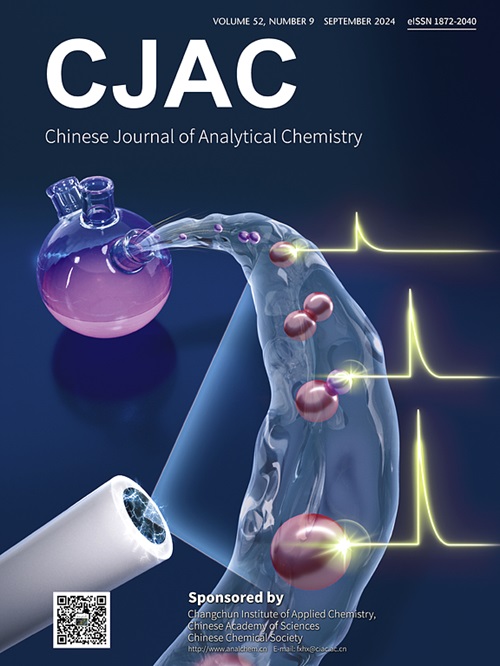SERS and fluorescence dual-mode sensing strategy based on competitive host-guest interaction for cholesterol and amantadine detection
IF 1.2
4区 化学
Q4 CHEMISTRY, ANALYTICAL
引用次数: 0
Abstract
Cholesterol is currently most detected by enzyme immunoassay, which is expensive and complicated. Therefore, it is necessary to develop new simple and effective non-enzymatic methods for cholesterol detection. Cholesterol and amantadine have small Raman cross sections and low affinity for metal surfaces, seriously limiting direct and effective SERS detection. Based on competitive interactions between target substances and R6G in β-cyclodextrin (β-CDs) cavities on the surface of cyclodextrin functionalized silver nanoparticles (Ag-β-CDs), a sensor was designed for detecting cholesterol and amantadine by surface enhanced Raman spectroscopy (SERS) and fluorescence (FL) dual modes. R6G entered hydrophobic cavities of Ag-β-CDs through hydrophobic interaction to form host-guest inclusion complexes resulting in fluorescence quenching, adding competitive guest cholesterol or amantadine that bound more strongly to cyclodextrins replaced R6G and recovered its fluorescence. Meanwhile, Ag-β-CDs were also used as SERS substrates. One cholesterol forms more stable inclusion complexes with two Ag-β-CDs nanoparticles, causing some degree of Ag-β-CDs aggregation and generating hot spots to enhance SERS signals of free R6G; Spatial structure of amantadine and extremely strong binding to β-CDs made it bind to only one β-CD, competing out R6G molecules to keep them away from electromagnetic-enhanced regions, and SERS signals weakened. In addition, the dual-mode sensing strategy was successfully applied to detect cholesterol and amantadine in real samples, and the two sets of data obtained complemented and verified each other with the advantages of high accuracy and sensitivity, which has great application prospects in disease surveillance and drug control.

基于竞争主客体相互作用的SERS和荧光双模传感策略用于胆固醇和金刚烷胺检测
目前检测胆固醇的方法主要是酶免疫分析法,这种方法既昂贵又复杂。因此,有必要开发新的简单有效的非酶检测胆固醇的方法。胆固醇和金刚烷胺的拉曼截面小,对金属表面的亲和力低,严重限制了直接有效的SERS检测。基于环糊精功能化银纳米粒子(Ag-β-CDs)表面β-环糊精(β-CDs)空腔中靶物质与R6G的竞争相互作用,设计了一种表面增强拉曼光谱(SERS)和荧光(FL)双模式检测胆固醇和金刚烷胺的传感器。R6G通过疏水相互作用进入Ag-β-CDs的疏水空腔,形成主-客体包合物,导致荧光猝灭,加入与环糊精结合更强的竞争客体胆固醇或金刚烷胺取代R6G,恢复其荧光。同时,Ag-β-CDs也被用作SERS底物。一个胆固醇与两个Ag-β-CDs纳米颗粒形成更稳定的包合物,引起一定程度的Ag-β-CDs聚集并产生热点,增强了游离R6G的SERS信号;金刚烷胺的空间结构和与β-CD极强的结合使其只与一个β-CD结合,竞出R6G分子使其远离电磁增强区域,SERS信号减弱。此外,将双模传感策略成功应用于实际样品中胆固醇和金刚烷胺的检测,所获得的两组数据相互补充和验证,具有精度高、灵敏度高的优点,在疾病监测和药物控制方面具有很大的应用前景。
本文章由计算机程序翻译,如有差异,请以英文原文为准。
求助全文
约1分钟内获得全文
求助全文
来源期刊
CiteScore
3.60
自引率
25.00%
发文量
17223
审稿时长
35 days
期刊介绍:
Chinese Journal of Analytical Chemistry(CJAC) is an academic journal of analytical chemistry established in 1972 and sponsored by the Chinese Chemical Society and Changchun Institute of Applied Chemistry, Chinese Academy of Sciences. Its objectives are to report the original scientific research achievements and review the recent development of analytical chemistry in all areas. The journal sets up 5 columns including Research Papers, Research Notes, Experimental Technique and Instrument, Review and Progress and Summary Accounts. The journal published monthly in Chinese language. A detailed abstract, keywords and the titles of figures and tables are provided in English, except column of Summary Accounts. Prof. Wang Erkang, an outstanding analytical chemist, academician of Chinese Academy of Sciences & Third World Academy of Sciences, holds the post of the Editor-in-chief.

 求助内容:
求助内容: 应助结果提醒方式:
应助结果提醒方式:


